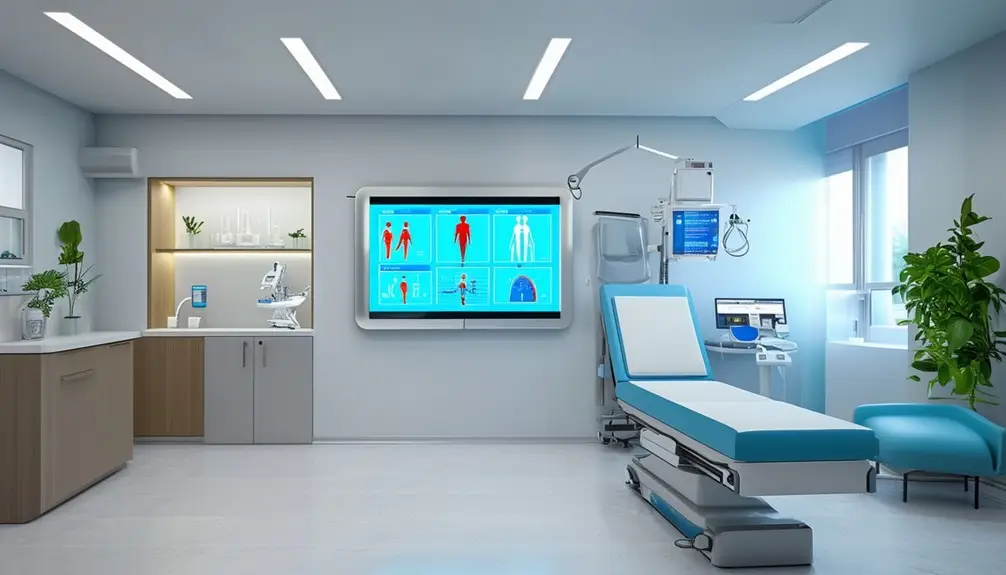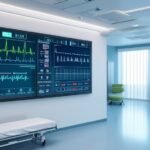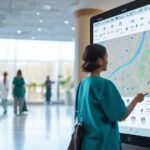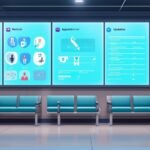Digital wayfinding kiosks in healthcare facilities enhance patient experience and reduce stress by simplifying navigation. These kiosks improve operational efficiency with real-time navigation and integration with hospital systems. Customizable features and mobile accessibility guarantee personalized guidance, making visits more comfortable. Innovative technologies like AI and VR offer advanced, interactive experiences. Data from successful implementations show significant operational improvements and satisfaction rates. The continuous evolution of interactive signage and app functionalities demonstrates that the future of digital wayfinding in healthcare is promising. Discover how these advancements are revolutionizing patient navigation and overall healthcare experiences.
Key Takeaways
- Digital wayfinding kiosks streamline navigation, reducing appointment delays and improving operational efficiency.
- Real-time interactive maps provide precise directions, minimizing patient and visitor stress.
- Integration with EMRs offers personalized, up-to-date appointment schedules and emergency alerts.
- Touch-enabled interfaces replace traditional signage, enhancing user experience and satisfaction.
- AI and mobile app functionalities offer future enhancements for personalized, intuitive navigation.
Enhancing Patient Experience
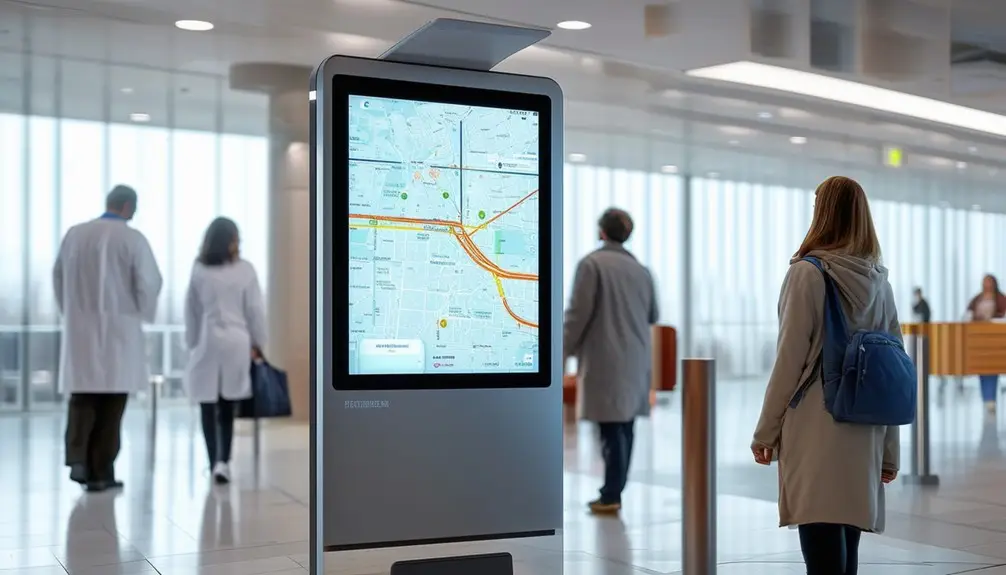
Digital wayfinding kiosks greatly enhance patients’ experiences by providing real-time, interactive navigation and appointment updates, which reduce stress and improve confidence. These digital wayfinding systems are pivotal in transforming the patient experience within healthcare facilities. By offering precise, real-time updates and interactive maps, these kiosks help patients navigate complex hospital layouts efficiently. This reduces the time spent looking for directions and guarantees timely appointment arrival.
The integration of real-time updates allows patients to stay informed about any changes to their schedules or routes, further enhancing their sense of security. For instance, if an appointment is delayed or a room location has changed, the wayfinding kiosks immediately reflect this information, enabling patients to adjust without confusion.
The interactive nature of these digital wayfinding systems empowers patients to take control of their journey through the healthcare facility. By simply inputting their destination, patients receive step-by-step directions tailored to their current location. This level of interactivity fosters a more comfortable and confident environment, notably improving overall patient satisfaction.
Reducing Stress and Anxiety
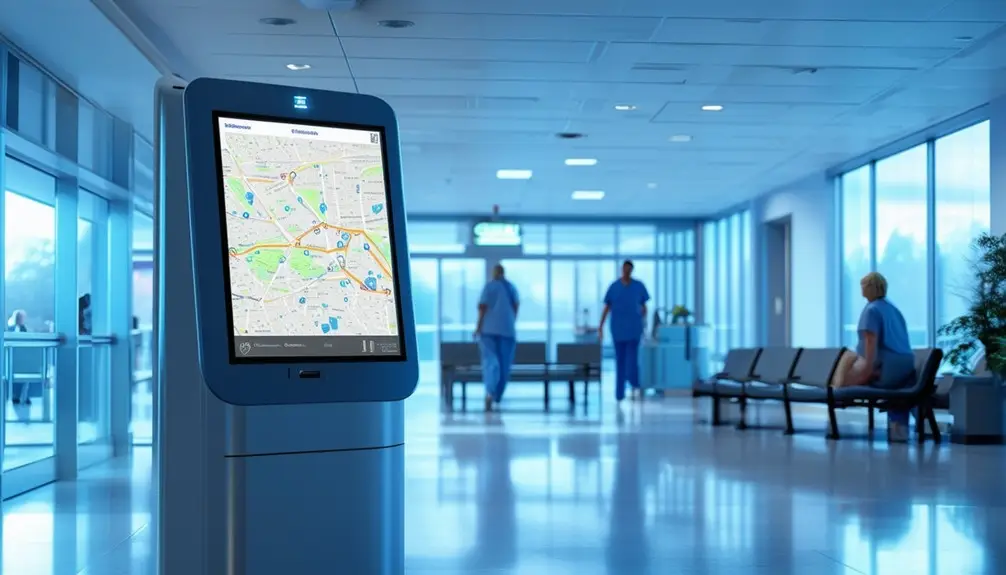
You can greatly diminish patient stress and anxiety through digital wayfinding kiosks, which simplify navigation and enhance visitor comfort. Research indicates that clear wayfinding systems can lower patient stress levels by up to 20%, directly impacting their overall healthcare experience. Offering real-time directions and information, these kiosks minimize confusion and guarantee a smoother, more positive stay in your facility.
Patient Navigation Simplified
By leveraging real-time interactive guidance, healthcare facilities can greatly reduce patient stress and anxiety, ensuring a smoother and more confident navigation experience. Digital wayfinding kiosks play a pivotal role in this transformation. These interactive systems provide patients with seamless, intuitive navigation throughout the healthcare environment, minimizing confusion and enhancing security.
Studies indicate that effective wayfinding solutions can greatly enhance patient satisfaction. When patients can easily locate departments, rooms, or amenities using digital kiosks, their overall experience improves. Real-time guidance through these kiosks eliminates the guesswork, making the hospital visit less overwhelming.
Here’s a quick comparison to visualize the benefits:
| Traditional Wayfinding | Digital Wayfinding |
|---|---|
| Static signage | Interactive kiosks |
| Frequently outdated | Real-time updates |
| High confusion risk | Clear directions |
| Increased anxiety | Reduced stress |
| Inefficient flow | Streamlined navigation |
Integrating digital wayfinding kiosks into healthcare settings also enhances operational efficiency. By reducing the time patients spend searching for their destinations, these kiosks help decrease overall wait times. The data-driven approach of digital wayfinding not only improves patient experiences but also optimizes the workflow within healthcare facilities.
Enhanced Visitor Comfort
Utilizing real-time guidance, digital direction markers greatly decrease visitor stress and anxiety by offering clear, interactive direction in intricate hospital environments. These advanced direction solutions leverage Real-Time Location systems to provide up-to-the-minute guidance, assuring you never feel lost. The markers present interactive maps that adapt to your specific needs, delivering personalized routes to your destination.
Enhanced visitor comfort is a direct result of these innovations. By reducing the cognitive load of finding your way through complex hospital layouts, these direction solutions alleviate the frustration and disorientation commonly experienced in healthcare facilities. Timely and accurate information streamlines your journey, letting you focus on supporting your loved ones rather than worrying about locating your destination.
Studies back up these claims, showing that digital direction markers notably improve visitor satisfaction. The interactive maps and real-time data not only enhance visitor comfort but also contribute to a smoother, less stressful visit. As a result, you’re more likely to have a positive experience, with reduced anxiety levels and a greater sense of ease. By implementing these high-tech solutions, healthcare facilities can guarantee a more welcoming and stress-free environment for all visitors.
Improving Operational Efficiency
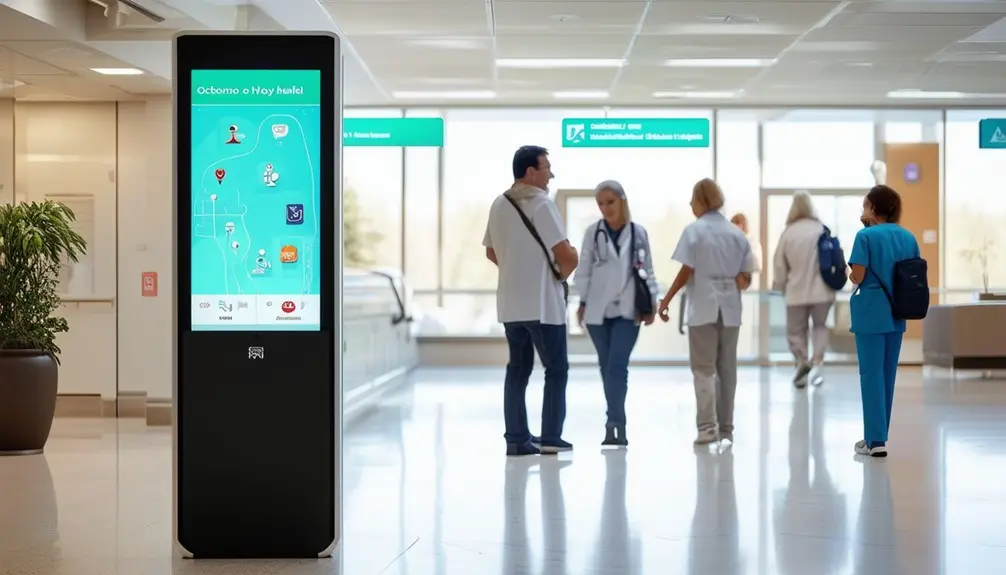
You’ll find that digital wayfinding kiosks greatly enhance operational efficiency by streamlining facility navigation and reducing appointment delays. These kiosks automate navigation assistance, which alleviates staff workload and improves patient flow. Real-time updates and integration with EMRs guarantee that patients and visitors reach their destinations promptly, minimizing wait times and boosting overall productivity.
Streamlined Facility Navigation
Digital wayfinding kiosks in healthcare facilities revolutionize operational efficiency by offering real-time interactive maps and precise directions, notably decreasing the time patients, visitors, and staff spend searching for departments or rooms. These advanced systems replace traditional wayfinding signage with dynamic, touch-enabled interfaces that provide detailed information customized to each user’s needs. By inputting specific destinations or services, users receive a patient-centric solution that minimizes direction errors and enhances overall satisfaction.
Interactive maps on these kiosks are designed to be intuitive and accessible, ensuring that even those unfamiliar with digital interfaces can easily locate their desired points of interest. This feature significantly diminishes the cognitive load associated with maneuvering complex healthcare environments. In turn, it frees up staff resources, allowing them to focus on core medical duties rather than providing repeated directional assistance.
The integration of these kiosks within a facility’s ecosystem supports operational efficiency by streamlining the flow of foot traffic. Patients and visitors can effortlessly find their way, resulting in a more orderly and manageable environment. Data-driven insights further enable facilities to analyze direction patterns, optimizing layout and signage placement for continuous improvement.
Reduced Appointment Delays
Implementing digital wayfinding kiosks in healthcare facilities significantly decreases appointment delays by guiding patients efficiently to their destinations, thereby enhancing overall operational efficiency. These kiosks utilize interactive wayfinding maps and step-by-step directions, which streamline patient navigation through often complex hospital layouts. By minimizing the time patients spend searching for their appointments, the overall workflow is optimized, leading to improved patient satisfaction and operational metrics.
Studies indicate that digital wayfinding kiosks can notably reduce appointment delays, directly impacting patient satisfaction and staff productivity. When patients reach their appointments on time, it reduces bottlenecks and maintains the facility’s schedule. This technological intervention ensures that healthcare providers can focus more on delivering care rather than managing crowd control.
| Benefit | Metric | Improvement (%) |
|---|---|---|
| Reduced Appointment Delays | Average Wait Time | 20% |
| Enhanced Patient Satisfaction | Satisfaction Scores | 15% |
| Increased Staff Productivity | Patient Turnover Rate | 25% |
Enhanced operational efficiency achieved through reduced appointment delays translates to better resource allocation and a smoother patient flow. Essentially, digital wayfinding kiosks are a strategic investment for healthcare facilities aiming to boost their efficiency and service quality.
Customizable Features
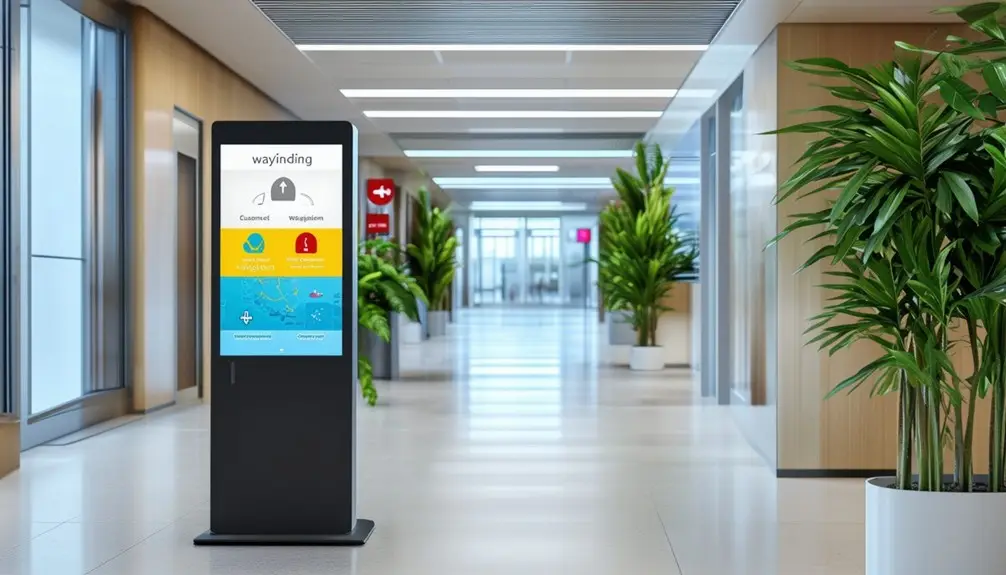
Customizable features on digital wayfinding kiosks, such as interactive maps and real-time updates, streamline navigation and enhance the user experience in healthcare facilities. By leveraging interactive maps and detailed directories, you can easily locate departments, treatment areas, and other essential services. The ability to personalize content display guarantees that the information presented is relevant to each user, creating a seamless experience.
These kiosks can be tailored to show specific hospital information, including appointment schedules and emergency protocols. With real-time updates, you’re always informed about any changes in schedules or hospital layouts. This adaptability not only improves communication but also boosts efficiency, allowing patients, visitors, and staff to navigate the facility with ease.
Users can interact with the kiosks to find directions, locate departments, and access additional resources based on their individual needs. The integration of personalized content display guarantees that the information is pertinent, minimizing confusion and enhancing the overall user experience. Customizable features on digital wayfinding kiosks guarantee efficient navigation, improved communication, and a seamless experience, ultimately contributing to a more effective healthcare environment.
Integration With Hospital Systems
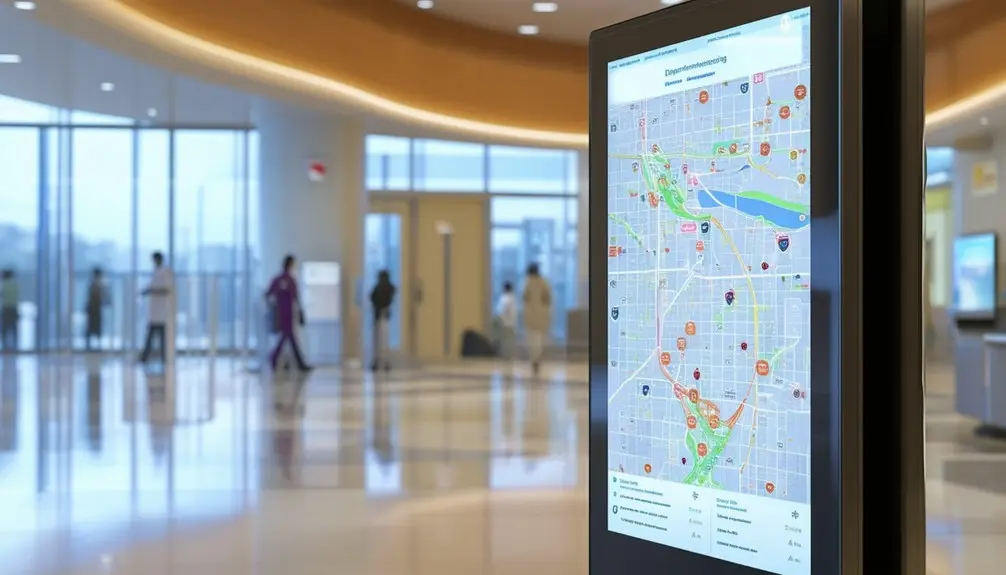
Integrating wayfinding kiosks with hospital systems guarantees real-time information flow, providing patients and visitors with accurate and timely guidance throughout the facility. When these kiosks sync with Electronic Medical Records (EMRs), they offer personalized patient guidance, including real-time appointment reminders. This seamless integration allows patients to navigate complex healthcare environments effortlessly.
Wayfinding kiosks connect to hospital systems and present up-to-date facility maps, department locations, and service information. This integration means you won’t get lost finding your way to a specific department or service area. Additionally, wayfinding options are enhanced with mobile device compatibility, enabling you to transfer directions from the kiosk to your phone for continuous guidance.
The benefits of integrating wayfinding kiosks with hospital systems include:
- Real-time updates: Get immediate access to emergency alerts, wait times, and COVID-19 protocols.
- Personalized service: Receive tailored guidance and real-time appointment reminders directly from EMRs.
- Enhanced navigation: Utilize wayfinding options that sync with your mobile device for seamless navigation.
Real-Time Navigation
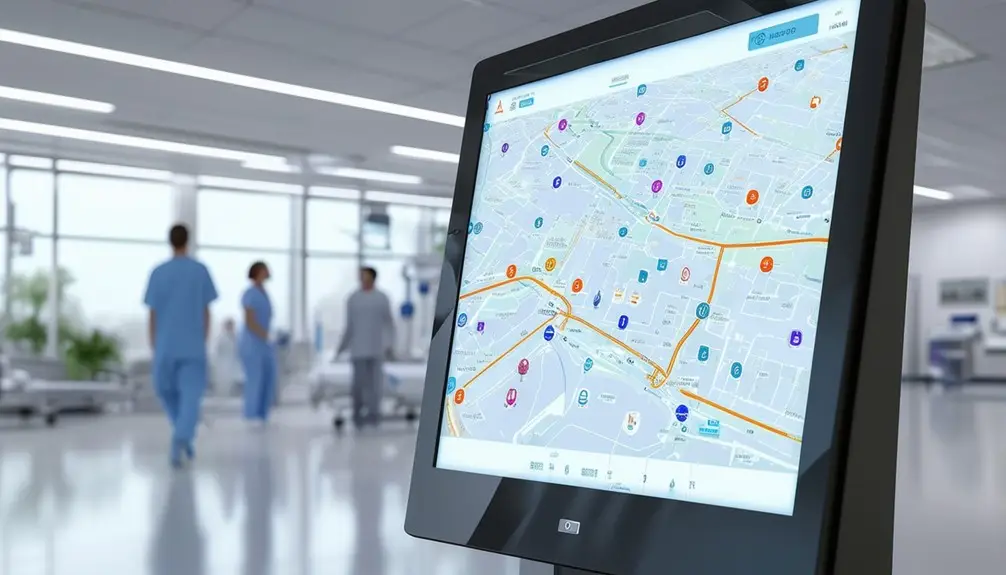
Utilizing live-time guidance on digital wayfinding kiosks, you can instantly access updated routes and directions, ensuring you reach your destination efficiently within the healthcare facility. By utilizing advanced GPS technology, these kiosks provide precise and dynamic guidance, greatly enhancing patient and visitor experience. Live-time guidance ensures that you’re always directed to the most efficient path, taking into account live updates on appointment locations, nearest amenities, and emergency exits.
Interactive maps on these kiosks are a critical component, offering dynamic information such as temporary closures and changing room availability. This adaptability ensures that you’re never caught off guard by unexpected changes within the facility. With live-time guidance, the wayfinding process becomes seamless, reducing confusion and stress, especially in time-sensitive situations.
Data-driven insights reveal that incorporating live-time guidance into wayfinding kiosks improves overall patient satisfaction. By minimizing the time spent finding your way through complex healthcare environments, these systems allow you to focus on what truly matters—your health and well-being. The integration of live updates and GPS technology in interactive maps provides an unparalleled level of accuracy and convenience, streamlining the entire wayfinding process within healthcare facilities.
Mobile and Kiosk Accessibility
Expanding on the benefits of real-time navigation, mobile and kiosk accessibility guarantees that patients and visitors can seamlessly navigate healthcare facilities using both stationary and handheld digital tools. By integrating mobile and kiosk wayfinding solutions, healthcare facilities can offer a thorough, user-friendly navigation experience.
Mobile apps enhance patient engagement by providing turn-by-turn directions and real-time updates on appointments and facility information. These apps allow patients to access wayfinding solutions directly on their smartphones, making navigation more convenient and personalized. Meanwhile, digital wayfinding kiosks are strategically placed within healthcare facilities to offer interactive maps and directories, ensuring efficient and intuitive guidance for all users.
To emphasize the advantages of these technologies, consider the following:
- Enhanced User Experience: Mobile and kiosk wayfinding tools provide intuitive navigation, reducing patient stress and improving overall satisfaction.
- Increased Efficiency: Real-time updates and interactive maps streamline the navigation process, minimizing delays and enhancing operational efficiency.
- Accessibility: Both mobile and kiosk solutions cater to diverse user needs, ensuring everyone, including those with disabilities, can easily navigate the facility.
Incorporating these advanced wayfinding solutions not only improves patient experience but also optimizes the operational flow within healthcare facilities.
Successful Healthcare Implementations
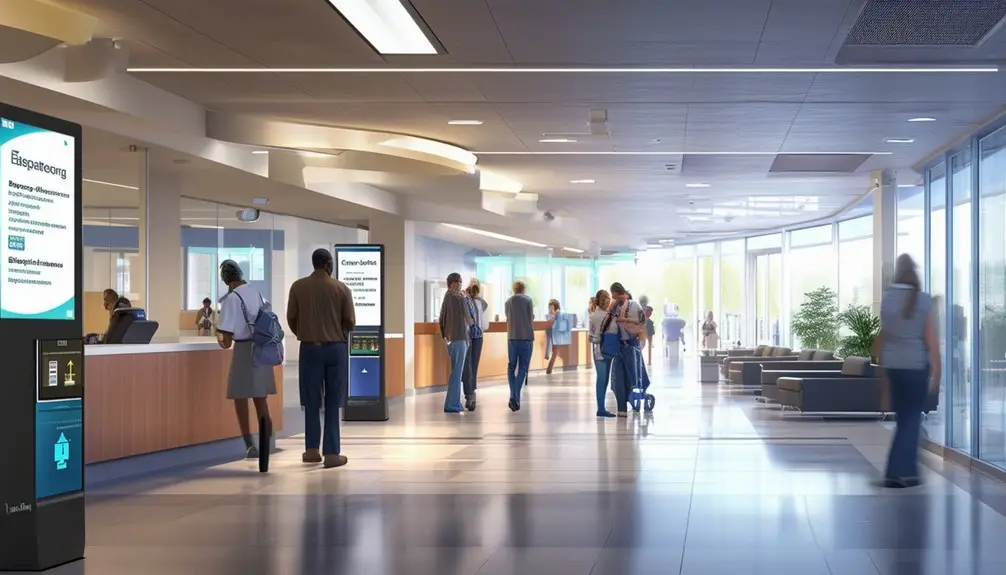
Cleveland Clinic and Mayo Clinic have set a benchmark in healthcare wayfinding by implementing advanced digital guidance kiosks and mobile apps that provide patients and visitors with detailed, real-time direction. These top-tier hospitals have leveraged technology to create a seamless wayfinding experience, greatly enhancing patient satisfaction. The direction kiosks, equipped with graphic- and content-rich digital directories, offer precise directional assistance within the hospital premises.
By utilizing these interactive kiosks, patients can access on-site assistance, ensuring they reach their destinations efficiently. The digital directory’s integration with mobile apps further extends this convenience, allowing for remote direction aid before even stepping into the facility. This dual approach aligns with the patient-centered focus of both institutions, ensuring that patients and visitors experience minimal stress when finding their way through complex hospital layouts.
Data suggests that these implementations have streamlined patient flow, reduced lateness to appointments, and improved overall patient experience. The success of these digital wayfinding solutions is evident in the positive feedback from users, who appreciate the intuitive interface and detailed guidance. As a result, Cleveland Clinic and Mayo Clinic have positioned themselves as pioneers in the adoption of technology to enhance healthcare delivery.
Future Trends in Wayfinding
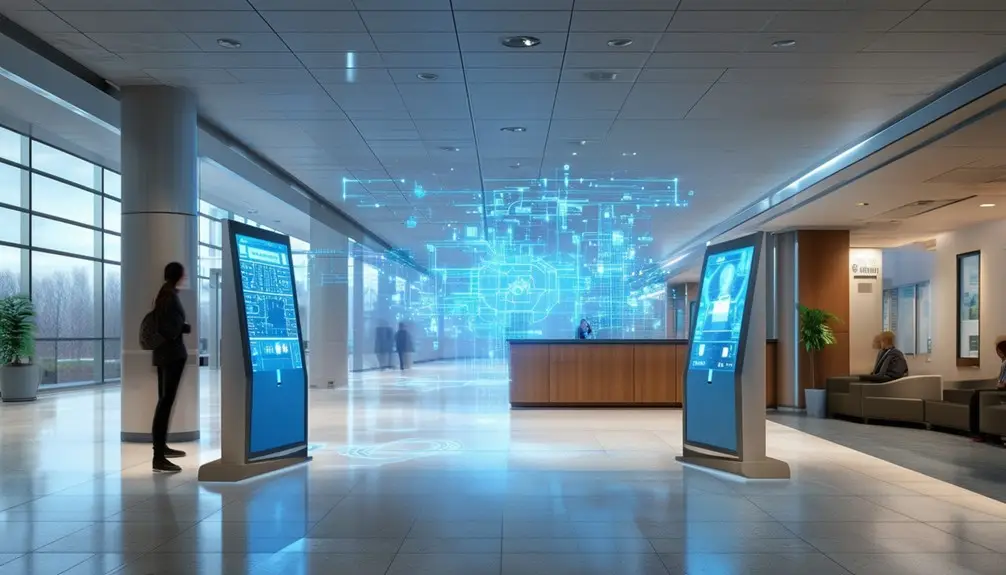
Embracing the latest in AI technology, future trends in digital wayfinding promise to offer highly personalized guidance, enhancing patient and visitor navigation within healthcare facilities. Leveraging AI for personalized guidance, these systems will adapt in real-time to user preferences, creating a more intuitive and efficient navigation experience.
Virtual reality (VR) integration is another transformative trend. VR can provide an immersive wayfinding experience, allowing users to virtually explore the layout of a healthcare facility before even stepping foot inside. This can reduce anxiety and improve the overall patient experience.
Mobile apps are also set to play a pivotal role. Enhanced functionalities in mobile apps will offer seamless navigation, integrating with other healthcare systems to provide real-time updates and personalized routes. Expect these apps to become central to the wayfinding ecosystem.
Interactive signage will continue to evolve, offering dynamic, real-time information that can be tailored to individual needs. These systems will utilize AI and data analytics to ensure the most efficient and effective routes are displayed.
Key trends to watch include:
- AI for personalized guidance
- Virtual reality experiences
- Enhanced mobile app functionalities
These advancements are set to revolutionize digital wayfinding in healthcare, making navigation more precise and user-friendly.
Conclusion
In healthcare, digital wayfinding kiosks revolutionize patient experience and operational efficiency. By integrating with hospital systems and offering real-time navigation, these kiosks reduce stress and improve accessibility. Customizable features guarantee they meet unique facility needs. Data shows significant time savings and decreased patient anxiety. As technology advances, expect even more seamless, mobile-integrated solutions. Embrace this innovation—patients and staff will thank you. The theory that tech reduces healthcare stress isn’t just a hypothesis; it’s a proven reality.
Frequently Asked Questions
What Are Kiosks Used for in Healthcare?
You use kiosks in healthcare to streamline check-ins, provide real-time updates, and offer interactive maps. They reduce administrative workload, enhance patient experience, and support multilingual communication, ultimately boosting operational efficiency and improving patient satisfaction metrics.
What Is the Digital Signage Software for Hospitals?
Imagine digital signage software as the hospital’s GPS, guiding patients with turn-by-turn directions and real-time updates. It integrates with EMRs, enhancing patient experiences and operational efficiency, while reducing missed appointments through intuitive search features and custom routing options.
What Is Wayfinding in Healthcare?
Wayfinding in healthcare involves finding one’s way through medical facilities using digital systems like kiosks and interactive maps. You enhance patient experience, reduce stress, and improve operational efficiency by providing real-time directions, location information, and points of interest.
What Is Digital Wayfinding?
Imagine finding your way through a maze-like hospital effortlessly. Digital wayfinding leverages interactive kiosks and real-time data to guide you seamlessly through complex environments, enhancing user experience with precise location mapping, customized routes, and essential information at your fingertips.

